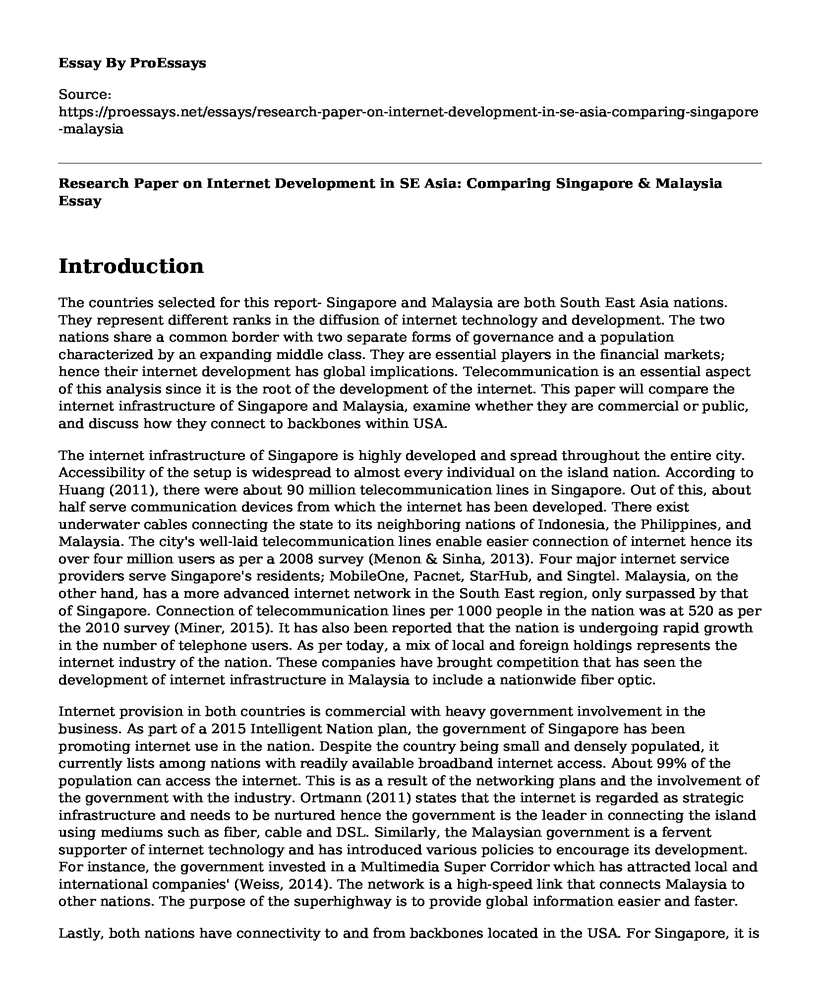Introduction
The countries selected for this report- Singapore and Malaysia are both South East Asia nations. They represent different ranks in the diffusion of internet technology and development. The two nations share a common border with two separate forms of governance and a population characterized by an expanding middle class. They are essential players in the financial markets; hence their internet development has global implications. Telecommunication is an essential aspect of this analysis since it is the root of the development of the internet. This paper will compare the internet infrastructure of Singapore and Malaysia, examine whether they are commercial or public, and discuss how they connect to backbones within USA.
The internet infrastructure of Singapore is highly developed and spread throughout the entire city. Accessibility of the setup is widespread to almost every individual on the island nation. According to Huang (2011), there were about 90 million telecommunication lines in Singapore. Out of this, about half serve communication devices from which the internet has been developed. There exist underwater cables connecting the state to its neighboring nations of Indonesia, the Philippines, and Malaysia. The city's well-laid telecommunication lines enable easier connection of internet hence its over four million users as per a 2008 survey (Menon & Sinha, 2013). Four major internet service providers serve Singapore's residents; MobileOne, Pacnet, StarHub, and Singtel. Malaysia, on the other hand, has a more advanced internet network in the South East region, only surpassed by that of Singapore. Connection of telecommunication lines per 1000 people in the nation was at 520 as per the 2010 survey (Miner, 2015). It has also been reported that the nation is undergoing rapid growth in the number of telephone users. As per today, a mix of local and foreign holdings represents the internet industry of the nation. These companies have brought competition that has seen the development of internet infrastructure in Malaysia to include a nationwide fiber optic.
Internet provision in both countries is commercial with heavy government involvement in the business. As part of a 2015 Intelligent Nation plan, the government of Singapore has been promoting internet use in the nation. Despite the country being small and densely populated, it currently lists among nations with readily available broadband internet access. About 99% of the population can access the internet. This is as a result of the networking plans and the involvement of the government with the industry. Ortmann (2011) states that the internet is regarded as strategic infrastructure and needs to be nurtured hence the government is the leader in connecting the island using mediums such as fiber, cable and DSL. Similarly, the Malaysian government is a fervent supporter of internet technology and has introduced various policies to encourage its development. For instance, the government invested in a Multimedia Super Corridor which has attracted local and international companies' (Weiss, 2014). The network is a high-speed link that connects Malaysia to other nations. The purpose of the superhighway is to provide global information easier and faster.
Lastly, both nations have connectivity to and from backbones located in the USA. For Singapore, it is an international trading and financial center. Connectivity is via a primary upstream link with a speed of 45 Mbps alike that of North America and shared among there ISPs. The three-share traffic at 2 Mbps with the other link is for backup and redundancy. For Malaysia, the network is a 10 Gbps link that connects MSC to the USA and can support various applications.
References
Huang, J. H. (2011). Analysis of Telecommunication Markets of India, Singapore and Thailandand and Research Their Global Competitiveness.
Menon, A., & Sinha, R. (2013). Implementation of internet of things in bus transport system of Singapore. Asian Journal of Engineering Research, Forthcoming, 44-89.
Miner, L. (2015). The unintended consequences of Internet diffusion: Evidence from Malaysia. Journal of Public Economics, 132, 66-78.
Ortmann, S. (2011). Singapore: Authoritarian but newly competitive. Journal of Democracy, 22(4), 153-164.
Weiss, M. (2014). New media, new activism: trends and trajectories in Malaysia, Singapore and Indonesia. International Development Planning Review, 36(1), 91-109.
Cite this page
Research Paper on Internet Development in SE Asia: Comparing Singapore & Malaysia. (2023, Feb 23). Retrieved from https://proessays.net/essays/research-paper-on-internet-development-in-se-asia-comparing-singapore-malaysia
If you are the original author of this essay and no longer wish to have it published on the ProEssays website, please click below to request its removal:
- Research Paper on Impact of the Internet on the Travel Industry
- Paper Example on Programmatic Advertising: Real-Time Marketing
- Essay Sample on Cyber Terrorism
- Preserving Human Dignity: Human Reproductive Cloning
- Essay Example on Big Data: Unlocking Hidden Insights for Better Results
- Essay Example on Facial Recognition: Verifying Identity with Biometric Data
- Essay Sample on The Internet: Blessing or Curse







